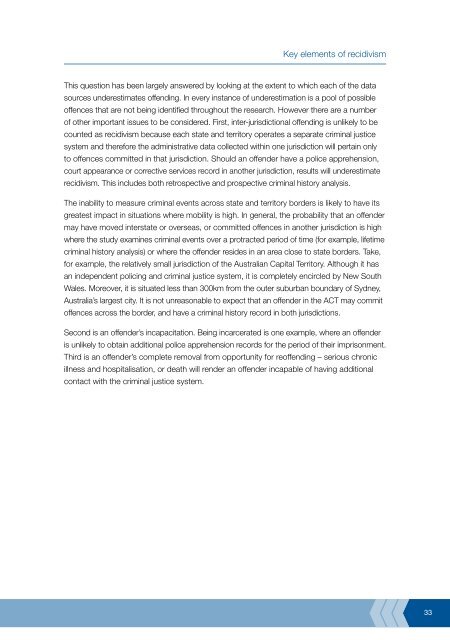Recidivism in Australia : findings and future research - Australian ...
Recidivism in Australia : findings and future research - Australian ...
Recidivism in Australia : findings and future research - Australian ...
You also want an ePaper? Increase the reach of your titles
YUMPU automatically turns print PDFs into web optimized ePapers that Google loves.
Key elements of recidivism<br />
This question has been largely answered by look<strong>in</strong>g at the extent to which each of the data<br />
sources underestimates offend<strong>in</strong>g. In every <strong>in</strong>stance of underestimation is a pool of possible<br />
offences that are not be<strong>in</strong>g identified throughout the <strong>research</strong>. However there are a number<br />
of other important issues to be considered. First, <strong>in</strong>ter-jurisdictional offend<strong>in</strong>g is unlikely to be<br />
counted as recidivism because each state <strong>and</strong> territory operates a separate crim<strong>in</strong>al justice<br />
system <strong>and</strong> therefore the adm<strong>in</strong>istrative data collected with<strong>in</strong> one jurisdiction will perta<strong>in</strong> only<br />
to offences committed <strong>in</strong> that jurisdiction. Should an offender have a police apprehension,<br />
court appearance or corrective services record <strong>in</strong> another jurisdiction, results will underestimate<br />
recidivism. This <strong>in</strong>cludes both retrospective <strong>and</strong> prospective crim<strong>in</strong>al history analysis.<br />
The <strong>in</strong>ability to measure crim<strong>in</strong>al events across state <strong>and</strong> territory borders is likely to have its<br />
greatest impact <strong>in</strong> situations where mobility is high. In general, the probability that an offender<br />
may have moved <strong>in</strong>terstate or overseas, or committed offences <strong>in</strong> another jurisdiction is high<br />
where the study exam<strong>in</strong>es crim<strong>in</strong>al events over a protracted period of time (for example, lifetime<br />
crim<strong>in</strong>al history analysis) or where the offender resides <strong>in</strong> an area close to state borders. Take,<br />
for example, the relatively small jurisdiction of the <strong>Australia</strong>n Capital Territory. Although it has<br />
an <strong>in</strong>dependent polic<strong>in</strong>g <strong>and</strong> crim<strong>in</strong>al justice system, it is completely encircled by New South<br />
Wales. Moreover, it is situated less than 300km from the outer suburban boundary of Sydney,<br />
<strong>Australia</strong>’s largest city. It is not unreasonable to expect that an offender <strong>in</strong> the ACT may commit<br />
offences across the border, <strong>and</strong> have a crim<strong>in</strong>al history record <strong>in</strong> both jurisdictions.<br />
Second is an offender’s <strong>in</strong>capacitation. Be<strong>in</strong>g <strong>in</strong>carcerated is one example, where an offender<br />
is unlikely to obta<strong>in</strong> additional police apprehension records for the period of their imprisonment.<br />
Third is an offender’s complete removal from opportunity for reoffend<strong>in</strong>g – serious chronic<br />
illness <strong>and</strong> hospitalisation, or death will render an offender <strong>in</strong>capable of hav<strong>in</strong>g additional<br />
contact with the crim<strong>in</strong>al justice system.<br />
33















